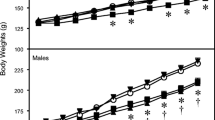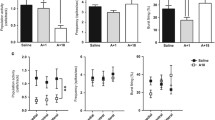Abstract
We have examined the anxiolytic activity of acute and chronic antidepressant treatment in an animal model of anxiety involving novelty-suppressed feeding. Rats were food deprived for 48 h, placed into a novel environment containing food, and the latency to begin eating was recorded. Chronic (21 days), but not acute injections of desipramine (DMI; 10 mg/kg) and amitriptyline (AMI; 10 mg/kg) significantly reduced the latency to begin eating compared to controls, but the percentage decrease was not as great as that seen with either acute or chronic treatment with diazepam (2 mg/kg) or adinazolam (20 mg/kg). A time course study indicated that at least 2 weeks of treatment was necessary to observe a significant anxiolytic effect of antidepressants. The anxiolytic effect of the antidepressants was specific to the novel environment, as 2 weeks of treatment with either diazepam or DMI did not influence the latency to begin eating in the home cage. Finally, a single dose of the central benzodiazepine receptor antagonist, Ro15-1788 (20 mg/kg), given 15 min prior to testing, did not block the anxiolytic effects of chronic DMI, while it completely eliminated the effect of chronic diazepam treatment. These data suggest that antidepressants acquire anxiolytic properties following chronic administration and that this effect appears to be independent of the benzodiazepine receptor system.
Similar content being viewed by others
References
Aprison MH, Ferster CB (1961) Neurochemical correlates of behavior: Correlation of brain monoamine oxidase activity with behavioral changes after iproniazid and 5-hydroxytryptophan. J Neurochem 6:350–357
Ashton H (1984) Benzodiazepine withdrawal: An unfinished story. Br Med J 288:1135–1140
Ballenger JC, Sheehan D, Jacobsen G (1977) Anti-depressant treatment of severe phobic anxiety. Paper read before the 130th annual meeting of the American Psychiatric Association, Toronto
Banarjee SP, Kung LS, Riggi SJ, Chandra SK (1977) Development of β-adrenergic receptor subsensitivity by anti-depressants. Nature 268:455–456
Barbaccia ML, Ravizza L, Costa E (1986) Maprotiline: an antidepressant with an unusual pharmacological profile. J Pharmacol Exp Ther 236:307–312
Bouthillier A, Montigny C de (1987) Long-term anti-depressant treatment reduces neuronal responsiveness to flurazepam: an electrophysiological study in the rat. Neurosci Lett 73:271–275
Britton DR, Thatcher-Britton R (1981) A sensitive open-field measure of anxiolytic drug activity. Pharmacol Biochem Behav 15:577–582
Busto U, Sellers EM, Naranjo CA, Cappell H, Sanchez-Craig M, Sykora K (1986) Withdrawal reaction after long-term therapeutic use of benzodiazepines. N Engl J Med 315:854–859
Charney DS, Menkes DB, Heninger GR (1981) Receptor sensitivity and the mechanism of action of antidepressant treatment. Arch Gen Psychiatry 38:1161–1179
Cole SO (1983) Combined effects of chlordiazepoxide treatment and food deprivation on concurrent measures of feeding and activity. Pharmacol Biochem Behav 18:369–372
Cooper SJ (1980) Effects of chlordiazepoxide and diazepam on feeding performance in a food preference test. Psychopharmacology 69:73–78
Cooper SJ (1985) Bidirectional control of palatable food consumption through a common benzodiazepine receptor: Theory and evidence. Brain Res Bull 15:397–410
Cooper SJ, Yerbury RE (1986) Midazolam-induced hyperphagia and FG-7142-induced anorexia: behavioral characteristics in the rat. Pharmacol Biochem Behav 25:99–106
Davis M, Redmond E, Baraban JM (1979) Noradrenergic agonists and antagonists: effect on conditioned fear as measured by the potentiated startle paradigm. Psychopharmacology 65:111–118
File SE (1986) Aversive and appetitive properties of anxiogenic and anxiolytic agents. Behav Brain Res 21:189–194
File SE, Tucker JC (1986) Behavioral consequences of antidepressant treatment in rodents. Neurosci Biobehav Rev 10:123–134
Hoehn-Saric R (1982) Neurotransmitters in anxiety. Arch Gen Psychiatry 92:735–742
Hollister LE (1978) Clinical pharmacology of psychotherapeutic drugs. Churchill Livingstone, New York
Kahn RJ, McNair D, Lipman RS, Covi L, Rickels K, Downing R, Fisher S, Frankenthaler LM (1986) Imipramine and chlordiazepoxide in depressive and anxiety disorders. efficacy in anxious outpatients. Arch Gen Psychiatry 43:79–85
Kelly D (1973) Progress in anxiety states. Proc R Soc Med 66:252–255
Kilts CD, Commissaris RL, Rech RH (1981) Comparison of anti-conflict drug effects in three experimental models of anxiety. Psychopharmacology 74:290–296
Montigny C de, Aghajanian GK (1978) Tricyclic anti-depressants: long term treatment increases responsivity of rat forebrain to serotonin. Science 202:1303–1306
Muskin PR, Fyer AJ (1981) Treatment of panic disorder. J Clin Psychopharmacol 1:81–90
Owens RT, Tyrer P (1983) Benzodiazepine dependence: a review of the evidence. Drugs 25:385–398
Peroutka SJ, Snyder SH (1980) Chronic antidepressant treatment decreases spiroperidol-labelled serotonin receptor binding. Science 210:88–90
Poschel BPH (1971) A simple and specific screen for benzodiazepine-like drugs. Psychopharmacologia 19:193–198
Russell GFM, DeSilva P (1983) Observations in the relationship between anxiety and depressive symptoms during the course of depressive illness. Br J Clin Pharmacol 15:1475–1535
Schildkraut JJ (1965) The catecholamine hypothesis of affective disorders: a review of supporting evidence. Am J Psychiatry 122:509–522
Schuckit MA, Feighner JP (1972) Safety of high dose tricyclic antidepressant therapy. Am J Psychiatry 128:140–143
Sellinger-Barnette MS, Mendels J, Frazer A (1980) The effect of psychoactive drugs on β-adrenergic receptor binding sites in rat brain. Neuropharmacology 19:447–454
Shephard RA, Broadhurst PL (1982) Hyponeophagia an arousal in rats: effects of diazepam, 5-methoxy-N,N-dimethyltryptamine, d-amphetamine and food deprivation. Psychopharmacology 78:368–372
Stein L, Berger BD (1973) Anti-anxiety action of benzodiazepines: decrease in activity of serotonin neurons in the punishment system. In: Garattini S, Mussini E, Randall LO (eds) The benzodiazepines. Raven Press, New York, pp 299–326
Sulser F, Vetulani J, Mobley PL (1978) Mode of action of antidepressant drugs. Biochem Pharmacol 27:257–261
Suranyi-Cadotte BE, Dam TV, Quirion R (1984) Antidepressant-anxiolytic interaction: Decreased density of benzodiazepine receptors in rat brain following chronic administration of antidepressants. Eur J Pharmacol 106:673–675
Suranyi-Cadotte BE, Meaney MJ, Bodnoff SR, Lafaille F, Dalpe M, Quirion R (1987) Visualization of benzodiazepine and T-butylbicyclophosphorothionate [(35S)TBPS] binding sites following anxiolytic and anti-depressant treatment. Abstract Presented at the 17th annual meeting of the Society for Neuroscience, New Orleans
Widlocher D, Lecrubier Y, LeGoc Y (1983) The place of anxiety in depressive symptomatology. Br J Clin Pharmacol [Suppl] 15:171S–179S
Wise CD, Berger BD, Stein L (1972) Benzodiazepines: Anxiety-reducing activity by reduction of serotonin turnover in the brain. Science 77:180–183
Author information
Authors and Affiliations
Rights and permissions
About this article
Cite this article
Bodnoff, S.R., Suranyi-Cadotte, B., Aitken, D.H. et al. The effects of chronic antidepressant treatment in an animal model of anxiety. Psychopharmacology 95, 298–302 (1988). https://doi.org/10.1007/BF00181937
Received:
Revised:
Issue Date:
DOI: https://doi.org/10.1007/BF00181937




